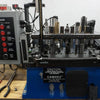If you pick up spent brass cases on the range, here are some of the most common issues you need to avoid.
Knowing the full history of a piece of brass is impossible. You don't know how hot the prior loads were or how many times the brass was reloaded. Because of this, you must visually inspect every piece of brass to ensure it's free from problematic imperfections or damage.
If you overlook these brass issues, you may run into catastrophic problems with your reloads. Rounds loaded with damaged brass can cause extreme damage to your guns or even injuries.
- Case Separation/Cracks
- Split Case Neck/Crack
- Dented Case Body
- Bulge in the Case
- Ejector Marks or Flat Primer
- Corrosion
Common Spent Brass Issues:
1. Case Separation/Cracks:
Inspect the brass for signs of case separation (cracks parallel to the base). This happens when the brass becomes too thin at the head or base. This usually results from over-reloaded brass or overstretch from a loose chamber. Get rid of these, they’re unusable.
2. Split Case Neck/Crack:
Another common area on once-fired brass where cracks can form is on the shoulder or neck. You’ll often find spent brass that has a split on the neck or a wrinkle in the shoulder. Toss these!
3. Dented Case Body:
Many things can cause dents in a brass case. Examples include a failure to eject or extract, someone stepping on it, or if someone has run over. A change in the structure of the brass can cause pressure to spike the next time it gets loaded. Because of this, you should throw these cases into the recycle pile.
4. Bulge in the Case:
Guns with unsupported chambers can cause bulging in a brass case. There are dies to help remove it, but be cautious. The bulge might be gone, but you still have a weakened case. If someone reloads this brass and uses that round in an unsupported chamber, the case can fail. If it does fail, your gun can be severely damaged and you could be injured. Some reloaders use bulged cases with success, but you should use EXTREME caution.
5. Ejector Marks or Flat Primer:
Excessive ejector marks or super flat primers can mean over-pressured rounds. You should not reload brass cases that have show signs of this kind of excessive pressure.
6. Corrosion:
If you encounter corroded brass cases, run them through a tumbler. This will allow you to better inspect how bad the corrosion has affected the case. If the brass hasn’t gotten thinner and shows no signs of cracks, it should be reloadable. But please be careful and check thoroughly.
Next time you're sorting brass in your man-shed, pay attention to these common spent brass issues. If you spot any problems, toss the affected cases into the recycle pile.
To shop bulk brass for sale that has already been sorted and inspected, consider shopping at Fancy Brass Co. Our expert staff inspects, sorts, cleans, and processes all spent brass cases to a level that will exceed your expectations.
To learn more about how our process specififcally sorts and eliminates these issues from our brass, read about it here: Our Process: What Sets Us Apart from Competitors



